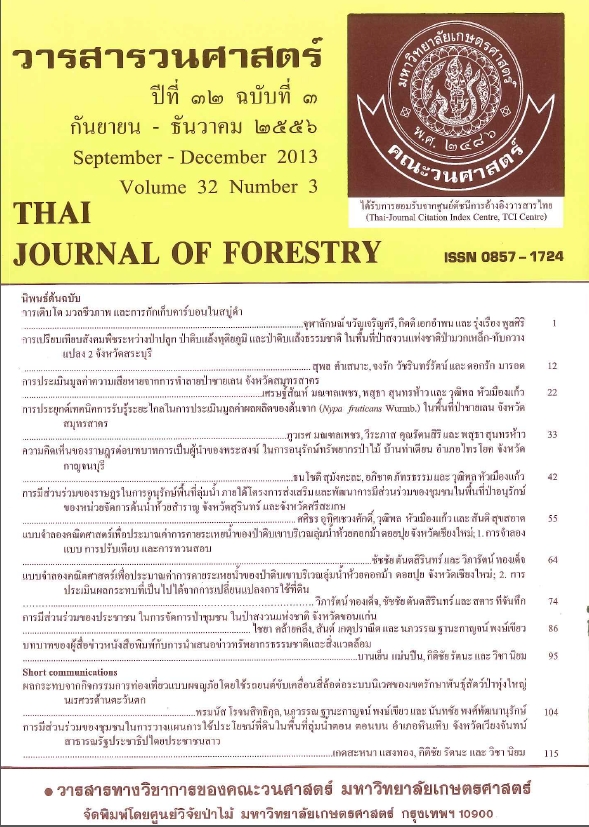แบบจำลองคณิตศาสตร์เพื่อประมาณค่าการคายระเหยน้ำของป่าดิบเขา บริเวณลุ่มน้ำห้วยคอกม้า ดอยปุย จังหวัดเชียงใหม่; 2. การประเมินผลกระทบที่เป็นไปได้จากการเปลี่ยนแปลงการใช้ที่ดิน
Main Article Content
บทคัดย่อ
การศึกษานี้เป็นการประยุกต์ใช้แบบจำลองทางคณิตศาสตร์ที่รวมแบบจำลองของ Penman, Penman - Monteith และ Rutter ประเมินผลกระทบต่อกระบวนการคายระเหยน้ำที่อาจจะเกิดขึ้นได้จากการเปลี่ยนแปลงป่าดิบเขาบริเวณลุ่มน้ำห้วยคอกม้า ดอยปุย จังหวัดเชียงใหม่ไปเป็นพื้นที่เกษตรกรรม โดยทดลองเปลี่ยนค่าพารามิเตอร์ต่างๆ ที่เกี่ยวข้องได้แก่ สภาพนำของปากใบสูงสุด (C*leaf) ดัชนีพื้นที่ผิวใบ (LAI) การระบายน้ำจากเรือนยอดเริ่มแรก (Ds) สัมประสิทธิ์การระบายน้ำจากเรือนยอด (b) สมรรถนะการกักเก็บน้ำของเรือนยอด (S) ความสูงของเรือนยอด (Z) และการปกคลุมของเรือนยอด (p) ตามภาพเหตุการณ์ที่กำหนดขึ้น ผลการศึกษาพบว่า พารามิเตอร์ที่มีผลต่อการเปลี่ยนแปลงค่าปริมาณการคายระเหยน้ำมาก คือ C*leaf LAI และ p โดยเมื่อ C*leaf และ LAI เพิ่มขึ้น ส่งผลต่อการคายน้ำของพืชมีค่าสูงขึ้น และทำให้การคายระเหยน้ำเพิ่มขึ้น มีอัตราการเปลี่ยนแปลงเฉลี่ยเพิ่มขึ้นใกล้เคียงกันคือร้อยละ 2.44 และมีผลในลักษณะตรงข้าม คือเฉลี่ยลดลงร้อยละ 2.71 และ 2.54 ตามลำดับ ส่วนการเพิ่มขึ้นของค่า Ds และ b มีผลทำให้การคายระเหยน้ำเพิ่มขึ้นในอัตราเฉลี่ยร้อยละ 0.42 และ 0.41 ตามลำดับ และมีค่าเท่ากับร้อยละ 0.94 และ 0.62 ตามลำดับในลักษณะตรงกันข้าม การเพิ่มขึ้นของค่า S ทำให้การคายน้ำมีค่าเพิ่มขึ้นคิดเป็นอัตราการเปลี่ยนแปลงเฉลี่ย เท่ากับร้อยละ 0.36 และ 0.46 ในลักษณะตรงกันข้าม พื้นที่ที่มีความสูงและการปกคลุมของเรือนยอดน้อยลง การคายระเหยจะน้ำลดลง คิดเป็นอัตราการเปลี่ยนแปลงเฉลี่ยลดลงร้อยละ 0.38 และ 1.97 ตามลำดับ และเมื่อนำผลการศึกษาดังกล่าวมาพิจารณาความเป็นไปได้ของการเปลี่ยนป่าดิบเขาไปเป็นพื้นที่เกษตร ซึ่งโดยทั่วไปพื้นที่เกษตรมีค่า C*leaf ที่มากกว่า และมีค่า LAI ความสูงและการปกคลุมของเรือนยอดน้อยกว่า ส่งผลให้ปริมาณการคายระเหยน้ำของพื้นที่เกษตรมีน้อยกว่าพื้นที่ป่าดิบเขา
คำสำคัญ: การคายระเหยน้ำ แบบจำลองคณิตศาสตร์ ลุ่มน้ำห้วยคอกม้า ป่าดิบเขา การเปลี่ยนแปลงใช้ที่ดิน
Downloads
Article Details

อนุญาตภายใต้เงื่อนไข Creative Commons Attribution-NonCommercial-NoDerivatives 4.0 International License.
ข้าพเจ้าและผู้เขียนร่วม (ถ้ามี) ขอรับรองว่า ต้นฉบับที่เสนอมานี้ยังไม่เคยได้รับการตีพิมพ์และไม่ได้อยู่ในระหว่างกระบวนการพิจารณาตีพิมพ์ลงในวารสารหรือสิ่งตีพิมพ์อื่นใด ข้าพเจ้าและผู้เขียนร่วม (ถ้ามี) ยอมรับหลักเกณฑ์และเงื่อนไขการพิจารณาต้นฉบับ ทั้งยินยอมให้กองบรรณาธิการมีสิทธิ์พิจารณาและตรวจแก้ต้นฉบับได้ตามที่เห็นสมควร พร้อมนี้ขอมอบลิขสิทธิ์ผลงานที่ได้รับการตีพิมพ์ให้แก่วารสารวนศาสตร์ คณะวนศาสตร์ มหาวิทยาลัยเกษตรศาสตร์ กรณีมีการฟ้องร้องเรื่องการละเมิดลิขสิทธิ์เกี่ยวกับภาพ กราฟ ข้อความส่วนใดส่วนหนึ่ง หรือ ข้อคิดเห็นที่ปรากฏในผลงาน ให้เป็นความรับผิดชอบของข้าพเจ้าและผู้เขียนร่วม (ถ้ามี) แต่เพียงฝ่ายเดียว และหากข้าพเจ้าและผู้เขียนร่วม (ถ้ามี) ประสงค์ถอนบทความในระหว่างกระบวนการพิจารณาของทางวารสาร ข้าพเจ้าและผู้เขียนร่วม (ถ้ามี) ยินดีรับผิดชอบค่าใช้จ่ายทั้งหมดที่เกิดขึ้นในกระบวนการพิจารณาบทความนั้น”


